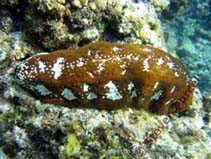Actinopyga mauritiana (Quoy & Gaimard, 1833)
Surf redfish| Native range | All suitable habitat | Point map | Year 2050 |

|
| This map was computer-generated and has not yet been reviewed. |
| Actinopyga mauritiana AquaMaps Data sources: GBIF OBIS |
Classification / Names Common names | Synonyms | CoL | ITIS | WoRMS
Holothuroidea | Holothuriida | Holothuriidae
Environment: milieu / climate zone / depth range / distribution range Ecology
Reef-associated; depth range 0 - 35 m (Ref. 122), usually 1 - 3 m (Ref. 92930). Tropical; 32°N - 36°S, 30°E - 124°W
Distribution Countries | FAO areas | Ecosystems | Occurrences | Introductions
Indo-Pacific.
Length at first maturity / Size / Weight / Age
Maturity: Lm ?, range 22 - ? cm Max length : 35.0 cm TL male/unsexed; (Ref. 122); common length : 20.0 cm TL male/unsexed; (Ref. 122); max. published weight: 1.5 kg (Ref. 104244)
Short description Morphology
Maximum width: 10 cm (Ref. 418). Body wall thickness: 0.6 cm. Body elongate, arched dorsally (bivium and flattened ventrally (trivium). Bivium sometimes wrinkled; wider in the middle; and tapering towards both ends. Papillae on bivium long and slender. Podia numerous on trivium, stout and crowded on the radii and interadii; calcareous disc of podia around 500 micrometer in diameter. Mouth ventral, surrounded by 25 short and stout tentacles, with a large collar of long papillae at their base. Anus surrounded by 25 stout anal teeth. Calcareous ring showing large radial pieces and interradials with triangular top. Cuvierian tubules few (10), short pink, and never expelled. Color of bivium variable, usually dark brown, with more or less distinct whitish spots. Trivium grains, rods bearing small spines, and denticulate pseudo-plates; dorsal tegument without grains, but with rosettes and denticulate rods; podia with some spinous rods and large rosettes. Tentacles with large rods bearing small spines.
Maximum depth from Ref. 122570. Harvested by artisanal fisheries throughout the Western Central Pacific, but probably less frequently than other species of Actinopyga. Collected by hand while wading on the reef at low tide. Processed product is not distinguished from those of other Actinopyga species; moderate commercial value.
Life cycle and mating behavior Maturity | Reproduction | Spawning | Eggs | Fecundity | Larvae
Sexual reproduction takes place during warm season. A species with a high potential fecundity and early sexual maturity (Ref. 122).
Main reference
References | Coordinator | Collaborators
Conand, C. 1998. (Ref. 122)
IUCN Red List Status (Ref. 130435: Version 2024-1)
Vulnerable (VU) (A2bd); Date assessed: 15 May 2010
CITES status (Ref. 108899)
Not Evaluated
CMS (Ref. 116361)
Not Evaluated
Threat to humans
Harmless
Human uses
Fisheries: commercial
| FishSource |
Tools
More information
Trophic Ecology
Food items
Diet
Food consumption
Ration
Predators
Diet
Food consumption
Ration
Predators
Ecology
Population dynamics
Life cycle
Distribution
Human Related
Aquaculture profile
Stamps, Coins Misc.
Stamps, Coins Misc.
Outreach
References
Internet sources
BHL | BOLD Systems | CISTI | DiscoverLife | FAO(Publication : search) | Fishipedia | GenBank (genome, nucleotide) | GloBI | Gomexsi | Google Books | Google Scholar | Google | PubMed | Tree of Life | Wikipedia (Go, Search) | Zoological Record
Estimates based on models
Preferred temperature
(Ref. 115969): 24.5 - 29.3, mean 28.4 (based on 3401 cells).
Resilience
(Ref. 69278):
Low, minimum population doubling time 4.5 - 14 years (K=0.12).
Price category
(Ref. 80766):
Unknown.



